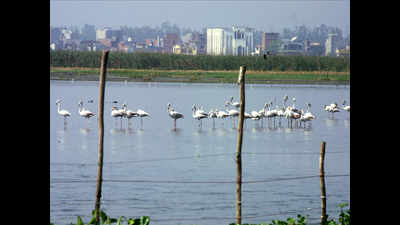- News
- City News
- delhi News
- Greater expectations: On the lookout for flamingos
Trending
This story is from February 18, 2019
Greater expectations: On the lookout for flamingos

Greater flamingo is popular resident of west Africa (File Photo)
NEW DELHI: This weekend, birders in NCR will step out in the wee hours in search of one particular bird species, the greater flamingo.

The Bombay Natural History Society (BNHS) is all set to conduct the first coordinated flamingo count across the country, which will include birding hotspots of NCR like Okhla, Dhanauri, Najafgarh and Sultanpur on February 23 and 24.
Even though there have been recent reports of decline in numbers of migratory birds in the city, this particular species of avian visitors has made some spots in the capital its seasonal home and can be sighted in large numbers, say birders.
Sohail Madan, centre manager at BNHS and in-charge of the count in Delhi and Uttar Pradesh, said this was the first initiative for a coordinated pan-India flamingo count. “They have a niche in their feeding grounds, certain kind of wetlands, as they eat the algae in the water and clean it up. Unlike last year, this time the water level is good at Okhla so flamingos have come,” Madan said.
The suitable habitat of greater flamingos for congregation and feeding includes marshland thickly covered with water hyacinth. Another prominent spot for flamingo sighting in the city is Najafgarh lake, which is now home to other resident wetland birds as well. The Najafgarh drain connects the lake to the Yamuna river near north Delhi’s Wazirabad.
“Over the past few years, a good number of flamingos were spotted at Najafgarh. Right now, there are nearly a thousand greater flamingos. Another species, lesser flamingo, on the other hand, doesn’t come to NCR,” birder Nikhil Devasar said.
The BNHS has undertaken several studies including colour tagging, satellite tracking of greater flamingo and conservation actions in the past decades. Currently, it is monitoring both lesser and greater flamingo population in some locations, including the Mumbai seascape. In 2017, it developed colour-banding scheme for flamingos in India in consultation with international agencies and banded several birds of both species.
BNHS has also identified both the species under priority list of birds that needs immediate conservation interventions. These two species are also included in the India’s National Action Plan for conservation of migratory birds and their habitats along Central Asian Flyway (CAF) by ministry of environment, forest and climate change.
As part of the upcoming flamingo count, participants can choose any of the two days or both the dates.
“Counts should ideally start around 7am for the inland sites. For the sites where flamingo movements depend on sea tides, the counts can be conducted when the congregation is highest. Evening counts in good light conditions are also encouraged in case the morning hours are not suitable owing to the sea tides,” a BNHS official said.

The Bombay Natural History Society (BNHS) is all set to conduct the first coordinated flamingo count across the country, which will include birding hotspots of NCR like Okhla, Dhanauri, Najafgarh and Sultanpur on February 23 and 24.
Even though there have been recent reports of decline in numbers of migratory birds in the city, this particular species of avian visitors has made some spots in the capital its seasonal home and can be sighted in large numbers, say birders.
The greater flamingo (Phoenicopterus roseus) is a popular resident of west Africa, sub-Saharan Africa, Mediterranean regions, southwest and south Asia (especially Pakistan, Bangladesh, Sri Lanka, coastal belt of Maharashtra, Gujarat, and Odisha in India). It migrates to the wetlands of Rajasthan, NCR, Uttar Pradesh and Madhya Pradesh (Chambal), and feeds on crustaceans, worms, insect larvae and seeds of marsh plants.
Sohail Madan, centre manager at BNHS and in-charge of the count in Delhi and Uttar Pradesh, said this was the first initiative for a coordinated pan-India flamingo count. “They have a niche in their feeding grounds, certain kind of wetlands, as they eat the algae in the water and clean it up. Unlike last year, this time the water level is good at Okhla so flamingos have come,” Madan said.
The suitable habitat of greater flamingos for congregation and feeding includes marshland thickly covered with water hyacinth. Another prominent spot for flamingo sighting in the city is Najafgarh lake, which is now home to other resident wetland birds as well. The Najafgarh drain connects the lake to the Yamuna river near north Delhi’s Wazirabad.
“Over the past few years, a good number of flamingos were spotted at Najafgarh. Right now, there are nearly a thousand greater flamingos. Another species, lesser flamingo, on the other hand, doesn’t come to NCR,” birder Nikhil Devasar said.
The BNHS has undertaken several studies including colour tagging, satellite tracking of greater flamingo and conservation actions in the past decades. Currently, it is monitoring both lesser and greater flamingo population in some locations, including the Mumbai seascape. In 2017, it developed colour-banding scheme for flamingos in India in consultation with international agencies and banded several birds of both species.
BNHS has also identified both the species under priority list of birds that needs immediate conservation interventions. These two species are also included in the India’s National Action Plan for conservation of migratory birds and their habitats along Central Asian Flyway (CAF) by ministry of environment, forest and climate change.
As part of the upcoming flamingo count, participants can choose any of the two days or both the dates.
“Counts should ideally start around 7am for the inland sites. For the sites where flamingo movements depend on sea tides, the counts can be conducted when the congregation is highest. Evening counts in good light conditions are also encouraged in case the morning hours are not suitable owing to the sea tides,” a BNHS official said.
End of Article
FOLLOW US ON SOCIAL MEDIA










